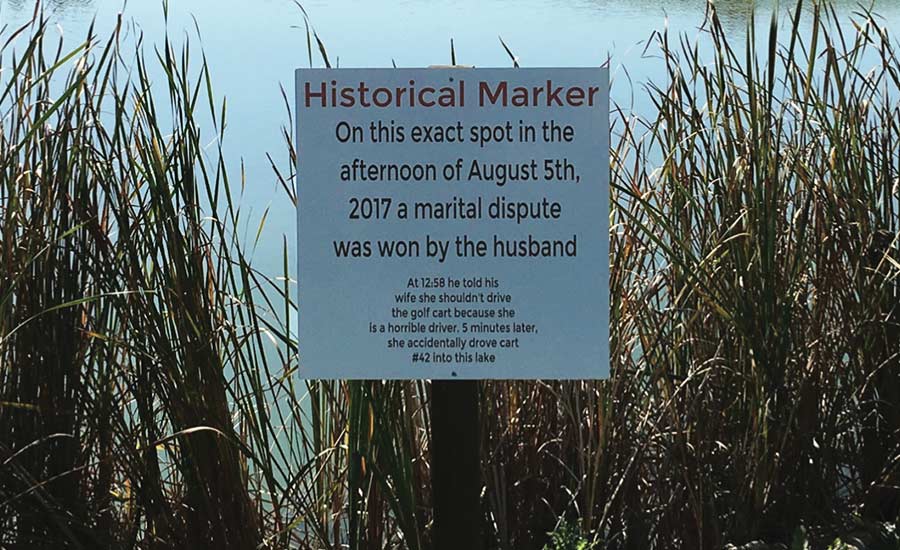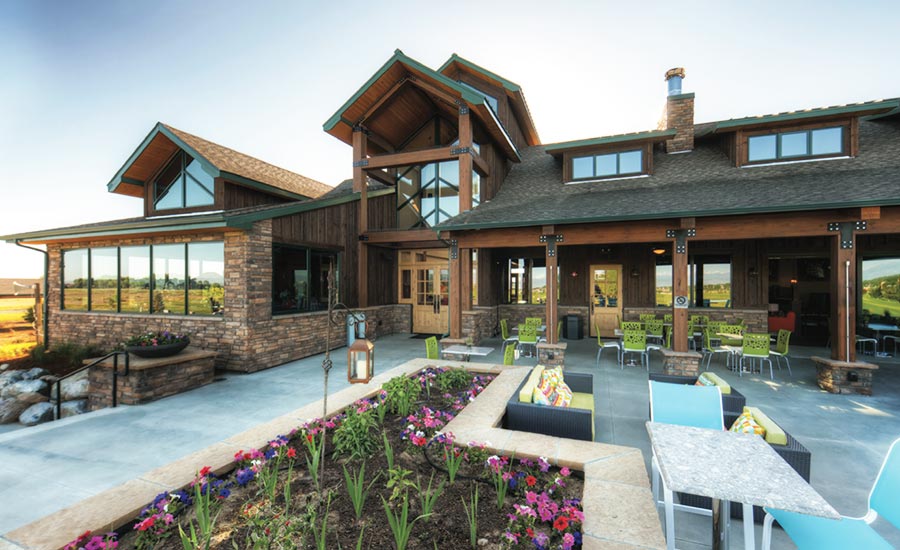Leaving Negative Thoughts Behind when You Head to the Tee Box
How does worrying impact our golf performance? What strategies can we use to manage it?

By Andy Bigford
WHEN SADDLEBACK Golf Club in Firestone launched its “Old Turd Tuesdays” back in 2012, the $29 offer included range balls, 18 holes and cart—plus an “all-you-can-eat” prune bar with a pint of Metamucil to wash it down. After a supposed Health Department intervention nixed the prune bar—along with an alleged Metamucil shortage—the course quickly substituted a hot dog and a “sodee pop” instead. There were a few grumbles from those who didn’t follow along with the joke, but rounds among the 60-and-older set immediately increased threefold, and this on a day of the week, at least pre-COVID-19, that is universally slow at golf courses (the cost is now $42, and OTT regularly draws 200 players).
This is all par for the course at a club which bills itself as “not normal,” whose scorecard declares “USGA rules apply only some of the time,” and which was named by Golf Digest as one of the country’s Top 10 “Most Cheerful” places to play.

“We are not pretentious people,” says Lanna O’Malley, who along with her husband Tom (ereryone calls him Whitey) are anomalies in Colorado as hands-on owner-operators. The two met in college at the University of Wisconsin-River Falls, and with partners built and operated a popular course there called Kilkarney Hills (they still own a share). Looking for opportunities to the west, they eventually partnered in the late 1990s with Vern Hamilton, a cash-crop farmer who had weathered one too many hailstorms and was ready for a change (he passed away in 2016). All the marketing studies said golf would continue to boom (wrong) and that the Northern Front Range would see dramatic population growth (right).
“There was nothing here back then,” she recalls of the Firestone-Frederick area, noting there wasn’t even a grocery store and they had to drive 12 miles east to Longmont to “buy a bolt.” “We had to trust it,” she says, and indeed the growth has come, with the Frederick-Firestone corridor now dotted with businesses, including a Safeway and Ace Hardware, and the region continuing to experience one of the highest growth rates in the country.
The O’Malleys hired veteran Colorado-born architect Andy Johnson to design Saddleback, which looks west to the mountains and features wide, rolling fairways; large, undulating greens; and plenty of wetlands and water. Saddleback stretches to 7,041 yards from the tips, with four more tee box options at 6,492, 6,054, 5,484, and 4,855 yards. Two man-made lakes bookend the south portion of the property, with a creek connecting them as it meanders through the back nine. It is fair and friendly, but with some bite, including three tough par fours: the split fairway 7th, the hazardous, well-bunkered 12th, and the long, narrow uphill 15th. For signatures, you could include two: The island par-3 4th and the drivable (over water), 322-yard dogleg par-4 16th, which highlights a strenuous four-hole closing stretch.
An expansive range beckons with fresh balls pyramided at each station, not fetched from a finicky code or token-operated ball dispenser. Most daily fee courses see the range as a revenue stream, but not Saddleback, which includes it in the price of the round. The club actually experimented five years ago with using Titleist Pro V1s on the range, getting three local businesses to sponsor (and pay for) the 13,000 new balls. Saddleback knew there would be substantial theft, so besides featuring the sponsor’s logo the balls were boldly marked “Stolen from Saddleback Golf Club.” Still, 8,000 disappeared in the first summer, and the club returned to using normal range balls. Another innovation, at least in non-COVID times: the bunkers feature buried vertical tubes as rake holders, taking the four-foot handle out of sight and play. The superintendent, Rob “Grass Whisperer” Flemming, is still ironing out the kinks, but it’s another example of Saddleback refusing to lay down on the job.
Initially operating out of a “temporary” double-wide trailer, Saddleback held off for 15-plus years on building its handsome, stone-and-timber 5,000-square-foot clubhouse, finally opening it in 2016. Meanwhile, they were expanding an adjacent pavilion, which also looks out on a small lake, perfect for weddings and events, though it has been dark this summer.
Like courses in Colorado and across the country, Saddleback is seeing unprecedented play in the COVID era, with increased rounds making up for the decline in Food and Beverage sales and the loss of weddings and events. Besides the nearby tri-towns (Firestone-Frederick-Dacono), the course draws from north Denver, Boulder, Longmont and Loveland; a few semi-regulars even make the trek down from Wyoming. Driven by Whitey, Saddleback is the first course in the state to employ dynamic pricing, provided by beta software designed by a French company. Besides offering discounts for earlier bookings, the system goes beyond the “capacity pricing” used by Golf Now and other tee times consolidators, factoring in historical trends as well. Demand during those periods is so high that the system wants to raise weekend and peak prices to $120 a round, but they capped it at roughly $83.

While few readers likely have made the drive 32 miles north of Denver on I-25 to play Saddleback, many have probably seen it on TV. It’s virtually the only course in the state to advertise regularly on the Golf Channel, with its quirky, 30-second spots starring the O’Malleys’ laid-back daughter, the blonde, wavy-haired Alex (she manages the pro shop). The latest series (“Let’s get you to the No. 1 tee”) was shot with an iPhone to convey a mellow atmosphere. Having featured proctologists, knitting bikers, Ninjas, shirtless firefighters, dinosaurs, ship captains, sleepwalkers and hobo golfers in the past, all the commercials tend to be pretty informal…and somehow memorable, which is the whole idea.
The creative spark comes from Rob “Robbo” Finley, who along with his dad, a former Denver firefighter, founded the nine-hole Missing Links course and driving range a mile away from Saddleback back in 1992 (it is now called Bella Rosa and owned by the town of Frederick). Finley was a stockbroker who opted for a change after working through Black Monday and its aftermath in the late 1980s. Missing Links began as a range and grew to include three, then nine holes. When they sold the course in the late 1990s and Saddleback opened, Finley became the O’Malleys’ jack-of-all trades. Tired of sending out pablum media messages on stereotypical golf events, he and the O’Malleys decided they’d talk to their customers as if they were sitting together at a bar, rather than in marketing doublespeak.

The non-normalcy is evident throughout Saddleback’s messaging, and perhaps includes lessons for other courses. When Saddleback sought to compete against chain discounters with its own equipment sale, the email subject line read, “We are not Dick’s.” From the scorecard: “No one cares how good you play. Everyone cares how fast you play. Keep up with the group in the front of you.” Buried in the website is a plug for the course’s corporate membership, “the ultimate little kissy-butt thing you can purchase to really impress clients.” Alas, in spelling out the various perks, it also concedes, “Since the raid, we no longer offer the massage.” Youth pay their age to play, but “if your child becomes a nuisance, we will feed them a bowl of sugar and give them a puppy before we send them home.” Touching all demographics, Saddleback even offers Husband Sitting: “Just leave a credit card for alcohol and golf.” The standard testimonial video praising the club’s lender, the local First National Bank branch, is titled “Lanna and Whitey beg for a bank loan.” It’s actually the only normal video among dozens on their site, many of which feature Saddleback regulars.
With the backing of the O’Malleys, who have a healthy sense of humor, Finley is always testing boundaries, though he admits the response to his “Karaoke-Trivia-Fireworks Night” was “mixed.”
Augusta has its plaque on the 15th honoring Gene Sarazen’s albatross, and Cherry Hills has its first tee commemoration of Arnold Palmer driving the green on the way to winning the 1960 U.S. Open. At Saddleback, the legendary historical marker (it’s actually just a cheap sign) at the island green 4th memorializes the time “the husband was actually right.” He had forbid his accident-prone wife to drive the cart, she ignored the warning, and the cart ended up at the bottom of the lake on the island par three. The couple’s cell phones and wallets were ruined, as were the cart’s transmission, engine and battery.
“I’ve always admired Saddleback, and it’s always in great shape,” says Ed Mate, the executive director of the Colorado Golf Association, which held its state women’s match play championship there in July (Saddleback has hosted various CGA events over the years, and co-hosted the Colorado Open in 2007). Colorado is a rarity with its abundance of municipally owned courses, which function by a different government playbook, enjoy deep pockets, can afford to discount greens fees, and don’t, for example, have to pay property taxes. Saddleback must promote entrepreneurial creativity, and financial discipline, to survive and thrive. When asked why he and Lanna share a broom-closet-sized office in the corner of the pro shop, Whitey says, “Offices don’t make money.”
During the initial COVID outbreak in March, Saddleback was one of the few courses in the state and country that never closed. Its social distancing guidelines are both extensive and readily enforced. One of COVID’s gloomiest impacts, Lanna believes, is the loss of the day-to-day interactions with customers that are so central to the Saddleback experience. During an interview on the expansive clubhouse patio, she excuses herself to check in on business, then returns with a just-met golfer who happens to hail from their former home in Wisconsin. He has played their Kilkarney course there several times and has deep ties in the community; the three immediately launch into a long reminisce on River Falls. Things are starting to return to normal, or not normal, at Saddleback.
This article was also featured in the Fall issue of Colorado AvidGolfer.
Colorado AvidGolfer is the state’s leading resource for golf and the lifestyle that surrounds it, publishing eight issues annually and proudly delivering daily content via coloradoavidgolfer.com.
How does worrying impact our golf performance? What strategies can we use to manage it?
The secret ingredient of Colorado golf course success is well-fed caddies, cooks and groundskeepers
Colorado State grad Davis Bryant opens up on his path to the pros and what keeps him busy when he’s off the course
The staff at Dream Makers Landscape is ready to help you enhance the look and feel of your property with our exceptional landscaping projects